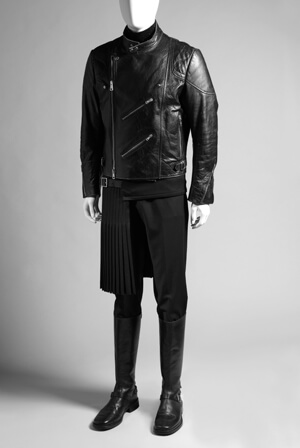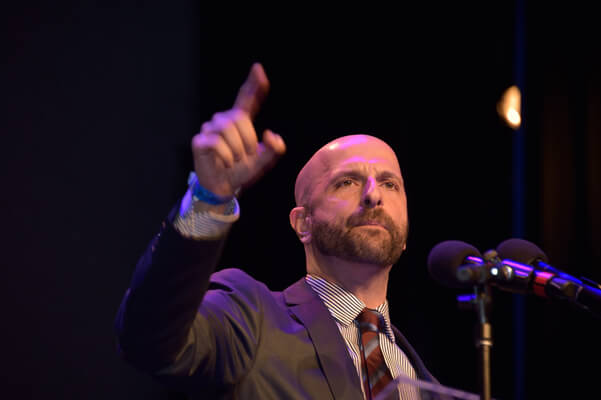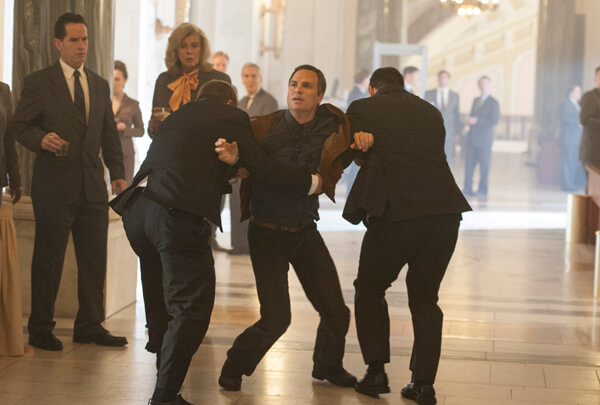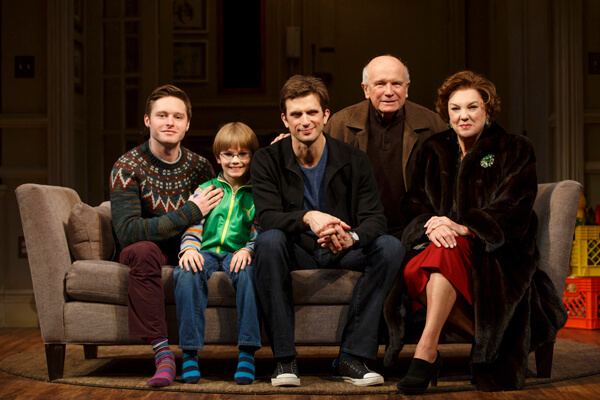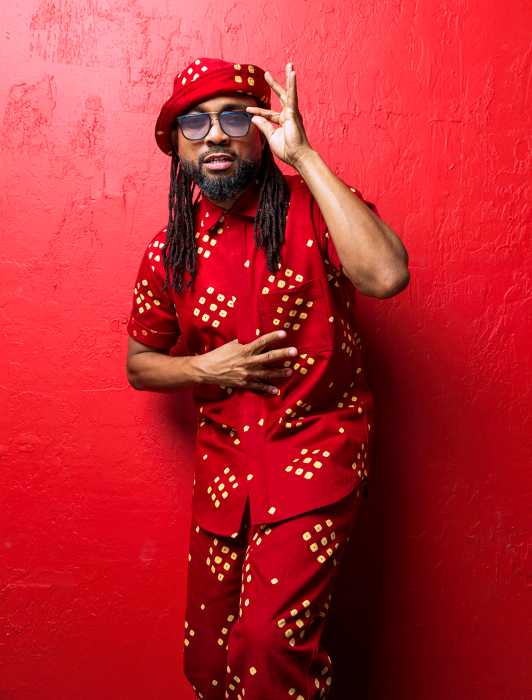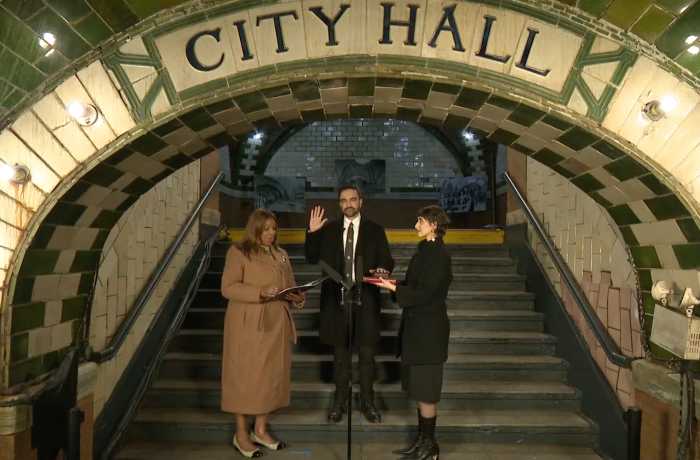An American day dress, circa 1882. | THE MUSEUM AT FIT
The fact that gays, lesbians, and bisexuals have long ranked as the greatest designers in fashion history is, of course, no surprise to anyone. What is surprising is how long it has taken any museum to give them their full, out, and proud due.
This oversight has happily been gloriously addressed with the Fashion Institute of Technology’s exhibit “A Queer History of Fashion: From the Closet to the Catwalk.” Curated by Valerie Steele and Fred Dennis, it is nothing less than a comprehensive history of three centuries of style, all of it wonderfully filtered through the eyes, minds, and talent of some of the most creative queers who ever threaded a needle or put pen to sketchpad.
“This was Fred’s idea and as soon as we thought about it, it seemed perfect,” Steele told me. “Such an important, original topic and it’s amazing that it hasn’t been done, apart from a handful of really small shows at gay and lesbian centers. There has never been a full-scale show of the history of LGBTQ involvement in fashion.”
FIT’s celebration of our collective sartorial genius
A three-piece neo-Edwardian suit, originally worn by Bunny Rogers and now in the collection of Hamish Bowles. | THE MUSEUM AT FIT
The show starts in the 18th century rather than in the golden gay ages of Ancient Greece or the Italian Renaissance.
“Those periods didn’t have any special gay style,” Steele explained. “Alexander the Great wore the same kind of toga that everyone else wore, ditto with Leonardo da Vinci, but there’s been a lot of research done about the sex and gender revolution in the 18th century in cities like London and Paris, where you see the for the first time a real gay impact on fashion. The press talks about three categories of men — ‘mollies,’ cross-dressing effeminate sodomites; ‘macaronis,’ foppish men some of whom may or may not have been gay; and the man milliners. Already men were making and selling clothes for women, and we have a charming quote about this ‘fraternity of pretty gentlemen united by a mutual love who like to make women’s fashions.’ So already there is a wealth of evidence.
“The 18th century look influenced Oscar Wilde in his aesthetic phase, and there is something a little queer about the 18th century gentlemen, even today, as in this Vivienne Westwood outfit which [Vogue editor] Hamish Bowles lent us. It was an important step in fashion history from this kind of dress to the beginnings of the way men dress now. We all know this change began around 1800, but the main reasons were the rise of capitalism and the spread of democracy. The appropriation of elite, aristocratic dress by middle and lower-class gay guys also helped turn the tide, which people then dropped and went in for something that looked more masculine and sober.”
Pierre Balmain, Jean Cocteau, and Christian Bérard’s riding costume for Cocteau’s “L'Aigle à Deux Têtes,” 1947. | BIGELOW TAYLOR/ COURTESY BEVERLY BIRKS
Influential French names like Vionnet, Chanel, Balenciaga, and Yves Saint Laurent are spotlighted, and, although not every designer in the show is gay, some were included for work which was either worn by prominent queers or influenced queer style.
“Vionnet was almost certainly bisexual and talked about how much she loved women and only designed for those whose bodies she liked, how sexy they were and how they moved,” Steele said. “Balenciaga was gay but it was kept so quiet until a recent biographer talked about it. Molyneux never admitted to being gay in public, but it was well known in small circles.
“And for all her rumored bisexuality, Chanel was very homophobic after the war and referred to Dior and Balenciaga as ‘a couple of queens dressing women like transvestites.’ She was very vicious in her attack on them as gay men became more important in the fashion business, which she said had been taken over by pederasts. And back in the 1920s and 1930s, she attacked women designers like Vionnet and Schiaparelli because they were her big competitors then. She was an equal opportunity hater.”
A man's clone look made up of a nylon flight jacket, with a T-shirt and jeans. | THE MUSEUM AT FIT
These designers and others contributed largely to the lifestyles and reputations of the fabled, glamorous “Best Dressed”-listed clotheshorses of the day. Doris Duke is represented by the “lobster dress” of Charles James, possibly America’s all-time greatest designer and the subject of this year’s Met Costume Institute show. He lived an unconventionally raffish life in the Chelsea Hotel and was befriended by the late, great illustrator Antonio Lopez, who did much to repair his tattered reputation brought on by years of eccentricity. Fashion icons Mrs. Harrison Williams and Tina Chow have their moments, and a sumptuous red and black Mainbocher evening ensemble is credited as the donation of “Mrs. Helen Vinson,” who was, actually, just Helen Vinson, a cherishable Hollywood supporting actress who specialized in slinky vamps and the “other woman,” often appearing far more chic than the stars themselves. She was, in life, Mrs. Fred Perry, the wife of the noted tennis champion.
The British, with their strong peacock tradition of dandyism and ineffable design gifts, are here in force, in the ultra-urbane personas of Oscar Wilde, Cecil Beaton, and Noël Coward, whose silk dressing gown symbolizes an entire era of cocktails and laughter. Two genius recent designers — both of them fallen, one by death and the other by scandal — Alexander McQueen and John Galliano, have gorgeous work in the show. A lesser-known figure is bespoke-loving Bunny Roger (1911-97), a flamboyantly out scion of Scot wealth, who was not only a couturier to such as Vivien Leigh and the inventor of Capri pants in 1949, but a World War II hero as well. He was known for rouging up heavily for battle and leading his troops waving a rolled-up Vogue magazine, crying “Come on girls, up and at ‘em!” His supposed advice regarding approaching German forces, “When in doubt, powder heavily.”
Gianni Versace’s leather evening dress, 1992. | FASHION GROUP FOUNDATION
The ultimate dandy émigré, Quentin Crisp, is also on hand. Designer Miguel Adrover saw his apartment being disassembled in the East Village and scavenged his filthy, stained mattress, making a distinctively funky coat from the ticking.
“It was really a mess,” Dennis said. “Apparently when they were making it, after washing it they all broke out with some kind of rash.”
Not surprising, as Crisp famously once said, “Why ever clean? The dust doesn’t get any worse after 10 years.”
The scruffy early look of Andy Warhol and the over-the-top bespangled one of Liberace are on display, as is a cool, mod Saint Laurent jumpsuit once sported by Larry Kramer, no less. But, in the celebrity department, the show’s biggest “get” has to be a collection of seven garments, from the Berlin Film Museum and never before shown in this country, worn by the immortal Marlene Dietrich. They include her man-tailored tuxedos, which challenged every notion of feminine sexuality in the 1930s, as well as a charming yachting ensemble that further establishes her as chicest movie star ever, on or off the screen.
Jean Paul Gaultier’ orange shirred velvet dress with cone bust and back lacing, 1984 | THE MUSEUM AT FIT
Two gay designers continually played with gender identity in their clothing — Gianni Versace and Jean Paul Gaultier. Fashion editor Hal Rubenstein has lent some outfits that were personally given to him by Versace along with the advice: “First, my dear, you put on your shorts or trousers and wrap one shirt around your waist, but let it flow in the back. Then you put on another shirt but leave it open… then put on your roller skates and fly down Ocean Avenue and be fabulous. They will be chasing after you, I promise.”
The notorious 1992 leather ball gown inspired by gay S&M culture is present, and Dennis told me that Versace had originally wanted to show it 15 years earlier, but was forced to repress it because of the general outrage it caused.
I personally own probably more Gaultier than of any other designer. From the time I first saw bracelets designed by him made of tin cans in a Paris boutique in the 1980s, I have always responded to his unique wit and oh-so French brand of sexy élan. The cone-busted silhouette, popularized by Madonna, is on protuberant display, as is Gaultier’s trademark sailor look, done, however, in head-to-toe shocking pink.
A John Bartlett ensemble, 2000. | THE COSTUME INSTITUTE/ METROPOLITAN MUSEUM OF ART
And then there are those looks that will all be familiar to a certain generation of gay men, especially the “clone” ensemble of cutoff jean shorts, boots, and wife-beater; the reversible nylon aviator jacket that everyone seemed to own at one time and which designer Claude Montana never gave up; and, of course, leather, in all of its pungent sexual significance. Who could ever have known that T-shirts from bars like the Eagle and the Mineshaft would ever be in a museum?
You may definitely get a little misty over the wall of the “fallen” — those designers who died, all of them far too young, during the initial AIDS rampage. Their careers may not have been the longest, but their talent blazed red hot while they were around and their work here is so timelessly fresh. You could don any of their outfits and still be the height of chic today. Perry Ellis was like a breath of spring in American ready-to-wear with his easy-breezy silhouettes and fabrics. Willi Smith was a groundbreaking black designer with an ethos similar to Ellis’ but with a more exotic flavor and greater innovation, as in his wrap pants that would fly out of stores like Capezio in the Village — downtown fashion central — in the late 1970s. His sense of fun was shared by my friend Patrick Kelly, another black design pioneer, who couldn’t get arrested in New York, but, with the aid of a one-way ticket to Paris secretly given him by supermodel Pat Cleveland, conquered the City of Light, like his Southern sister Josephine Baker before him. He was the first American named to the prestigious Chambre Syndicale.
Carmelo Pomodoro once partnered with the young Donna Karan at Anne Klein and really put that label on the map with a quintessentially American sophistication for working women who wanted to look professional and sexy. Bill Robinson was literally a shape-shifter for men, with his deconstruction of formerly boxy business attire at Calvin Klein and Yves Saint Laurent. Halston, of course, defined the 1970s with his starkly minimalist elegance and is represented by a pale blue gown donated by Lauren Bacall, which, like her, is the essence of sleek sensuality.
The “fallen” section is particularly close to the heart of curator Dennis.
“I knew Robinson when I first started working here,” he explained. “He used to come in and do research. AIDS wiped out an entire generation of talents — as well as stylists, photographers, hair and makeup artists — who should have been our Balenciagas, our old masters now, and could have been teaching our students. It’s important for these kids, especially the gay ones, to learn about their history, and realize that it wasn’t always this easy for us.”
The show ends, triumphantly, with a room devoted to queer marriage, featuring the actual outfits worn by three same-sex couples, two of them male and one female. A fabulously fitting finale to a truly pioneering exhibit.
A QUEER HISTORY OF FASHION: FROM THE CLOSET TO THE CATWALK | The Museum at FIT | Seventh Ave. at 27th St. | Through Jan. 4: Tue.-Fri, noon-8 p.m.: Sat., 10 a.m.-5 p.m. | Admission is free | Information on Nov. 8-9 symposiums & other special events at fitnyc.edu/musuem

